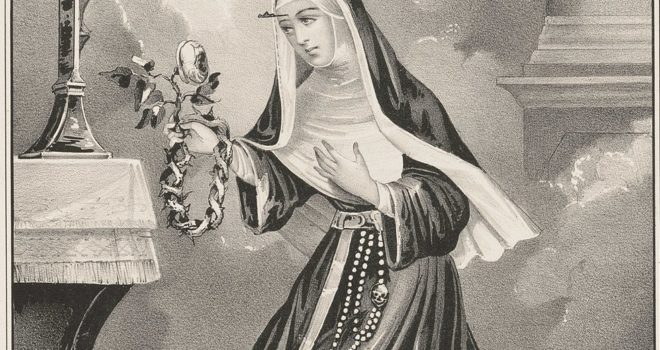In 1381, St. Rita was born in Spoleto, Italy, to elderly parents who were such examples of Christian charity that they were known as “Peacemakers of Jesus Christ.” As devout as they were, however, they seem to have been somewhat misguided when they insisted on St. Rita’s marriage, at the age of 12, to a man well known for his violent temper, despite her pleas to be allowed to enter a convent.
St. Rita, obedient to her parents’ wishes, entered into the marriage and became a model wife and mother, although she suffered much from her husband’s cruel treatment. She bore him two sons, and although she tried to set them an example by her devotion to prayer and to the sacraments, the boys seemed destined to follow in their father’s violent footsteps.
After 18 years of ceaseless prayer, St. Rita was rewarded with the penitent conversion of her husband. He begged her forgiveness and became a considerate, God-fearing man. But her joy was short-lived, for soon afterward her husband was murdered in a vendetta. When St. Rita learned that her sons planned to avenge their father’s murder, she prayed to God to take them from this world before they committed such a grievous sin. Almost immediately, both boys fell ill. She nursed them lovingly, and they both died, reconciled with God.
Now a widow and childless, St. Rita applied for admission to the Augustinian convent in Cascia, but was refused because its rule only permitted virgins. After much prayer and entreaty, an exception was finally granted to her and she was allowed to enter in 1413. The story is told that St. Rita was miraculously transported into the monastery itself, despite its locked doors; when the nuns found her there in the morning, they allowed her to stay, taking it as the will of God.
In the same way that St. Rita had been a model mother and wife, now she became an exemplary religious, becoming known for her great charity and severe penances. Her prayers were effective in obtaining for others remarkable cures and other favors from God, and she also worked to bring about a return to the Faith by those who had left it.
In 1441, St. Rita heard a sermon by St. James della Marca on the Crown of Thorns. Wishing to share in our Lord’s passion, she prayed fervently until one day she felt her forehead being pierced, as if by a thorn. The pain was extreme and the wound gave off an unpleasant odor, but St. Rita considered it a great grace. She prayed, “O loving Jesus, increase my patience accordingly as my sufferings increase.” The wound, which remained with her for the rest of her life, became gaping and so unattractive to those around her that she was eventually forced to live in seclusion. The wound did heal enough, however, for St. Rita to make a pilgrimage to Rome, but it returned the moment she returned to her convent.
St. Rita died on May 22, 1457, at the age of 76. Her body remained incorrupt for several centuries, at times giving off a sweet fragrance. It is said that at her beatification, the body of the saint raised itself up and opened its eyes. St. Rita is called “The Saint of the Impossible” and is particularly invoked in cases of matrimonial difficulties.
Lessons
1. Saint Rita can certainly be considered a saint for our time when people — both married and religious — have such great difficulty remaining faithful to their vows. Today, when divorce is so common, let us look to St. Rita’s example of patience and fortitude which eventually brought about the conversion of not only her husband, but her two sons as well.
2. Padre Pio, when asked if his stigmata hurt, once snapped in reply, “They’re not decorations!” Saints like Padre Pio and Rita of Cascia, who were allowed to experience physically a portion of our Lord’s passion, had to endure extreme pain daily. They never asked for these pains to be removed from them; they understood too well the redemptive nature of suffering. May we, too, make an effort to join our sufferings, great or small, with Jesus’ death on the cross. Then we may say with St. Paul, “In my body I complete what is lacking in the afflictions of Christ” (Col 1:24).

From Johnnette Benkovic’s Graceful Living: Meditations to Help You Grow Closer to God Day by Day
Remain in the holy love of Jesus. Remain in obedience to the holy Roman Church. Remain in peace and fraternal charity.
— Reported last words of St. Rita of Cascia
Johnnette’s Meditation
Love, obedience, peace, and charity. How can I bring these qualities into my life in some small way?













